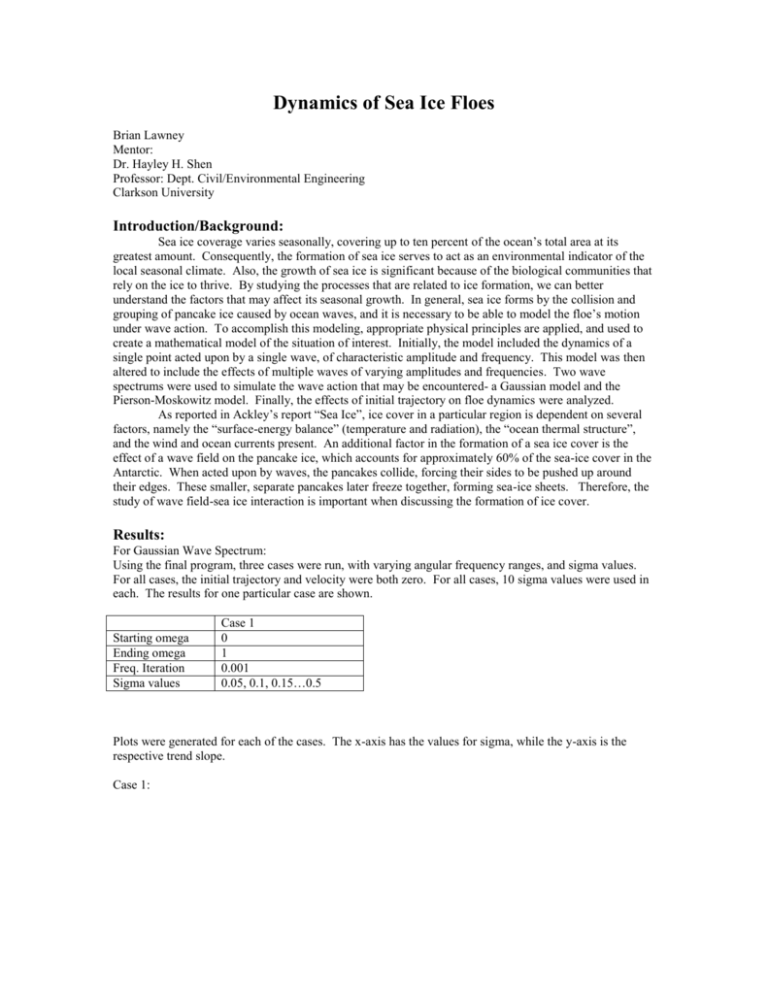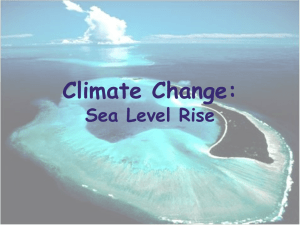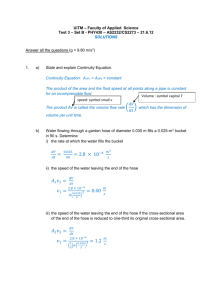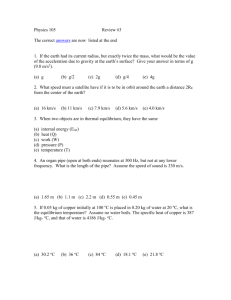Dynamics of Sea Ice Floes
advertisement

Dynamics of Sea Ice Floes Brian Lawney Mentor: Dr. Hayley H. Shen Professor: Dept. Civil/Environmental Engineering Clarkson University Introduction/Background: Sea ice coverage varies seasonally, covering up to ten percent of the ocean’s total area at its greatest amount. Consequently, the formation of sea ice serves to act as an environmental indicator of the local seasonal climate. Also, the growth of sea ice is significant because of the biological communities that rely on the ice to thrive. By studying the processes that are related to ice formation, we can better understand the factors that may affect its seasonal growth. In general, sea ice forms by the collision and grouping of pancake ice caused by ocean waves, and it is necessary to be able to model the floe’s motion under wave action. To accomplish this modeling, appropriate physical principles are applied, and used to create a mathematical model of the situation of interest. Initially, the model included the dynamics of a single point acted upon by a single wave, of characteristic amplitude and frequency. This model was then altered to include the effects of multiple waves of varying amplitudes and frequencies. Two wave spectrums were used to simulate the wave action that may be encountered- a Gaussian model and the Pierson-Moskowitz model. Finally, the effects of initial trajectory on floe dynamics were analyzed. As reported in Ackley’s report “Sea Ice”, ice cover in a particular region is dependent on several factors, namely the “surface-energy balance” (temperature and radiation), the “ocean thermal structure”, and the wind and ocean currents present. An additional factor in the formation of a sea ice cover is the effect of a wave field on the pancake ice, which accounts for approximately 60% of the sea-ice cover in the Antarctic. When acted upon by waves, the pancakes collide, forcing their sides to be pushed up around their edges. These smaller, separate pancakes later freeze together, forming sea-ice sheets. Therefore, the study of wave field-sea ice interaction is important when discussing the formation of ice cover. Results: For Gaussian Wave Spectrum: Using the final program, three cases were run, with varying angular frequency ranges, and sigma values. For all cases, the initial trajectory and velocity were both zero. For all cases, 10 sigma values were used in each. The results for one particular case are shown. Starting omega Ending omega Freq. Iteration Sigma values Case 1 0 1 0.001 0.05, 0.1, 0.15…0.5 Plots were generated for each of the cases. The x-axis has the values for sigma, while the y-axis is the respective trend slope. Case 1: 1.8 Slope of trend line 1.6 1.4 1.2 1 0.8 0.6 0.4 0.2 0 -0.2 0.05 0.1 0.15 0.2 0.25 0.3 0.35 0.4 0.45 0.5 Sigma Trajectory plot for sigma=0.10 drift velocity=1.7772 m/s 180 160 140 120 trajectory (m) 100 80 60 40 20 0 -20 0 10 20 30 40 50 time (s) 60 70 80 90 100 For Pierson-Moskowitz Wave Spectrum: Case 1 Starting omega 0.001 Ending omega 1 Freq. Iteration 0.001 Mean Wind Speed 10m/s Using the same factors as described above, the effects of different initial trajectories were investigated. Initial position is compared with drift velocity in the chart below. Initial position (m) Drift velocity (m/s) 0 0.31754534304866 61.638 0.31754804702541 123.276 0.31755025030751 184.914 0.31755196268396 Based on those results, and others taken, it should be clear that initial trajectory is not a significant factor in this MATLAB model. Conclusion: From the model with the Gaussian wave funtion, it can be seen that the initially small standard deviation results in a small trend slope, meaning there is relatively little drift velocity of the floe. However, the trend slope rises quickly from there, reaching a relative maximum typically at the second value for the standard deviation, at 0.2*(omega mean). This may suggest that the maximum drift velocity of a particular floe occurs when the standard deviation is set to one fifth of the mean angular frequency. Following the peak, the curves generally level off to a smaller value, typically much less than 1. Once again, this suggests small drift velocities. Based on the results from the more realistic Pierson-Moskowitz wave spectrum, it can be seen that this model does not account for the orientation of the ice floe, as the initial position does not matter when looking at drift velocities. Since the model was originally created to model the movement of a single point under wave action, this finding agrees. Acknowledgements: Thanks and appreciation to the advice and guidance of Dr. Hayley H. Shen, Dept. of Civil/Environmental Engineering, Clarkson University. References: Ackley, S.F., Sullivan, C.W. (1993) “Physical controls on the development and characteristics of Antarctic sea ice biological communities-a review and synthesis” Deep Sea Research I, Vol. 41. Ackley, S.F (1996) “Sea Ice” Encyclopedia of Applied Physics, Vol. 17. Ackley, S.F., Geiger, C.A., King, J.C., Hunke, E.C., Comiso, J. (2001) “The Ronne polynya of 1997/98: observations of air-ice-ocean interaction” Annals of Glaciology, Vol. 33. Kooyman, G.L., Hunke, E.C., Ackley, S.F., van Dam, R.P., and Robertson, G. (2000) “Moult of the Emperor Penguin: travel, location, and habitat selection” Marine Ecology Progress Series, Vol 204. Tucker, M.J. Waves in Ocean Engineering: Measurement, Analysis, Interpretation. New York, Ellis Horwood, 1991. Zhong, Y., Shen, H.H. (1994) “Drift of a Small Floe under Wave Action with and without a Reflecting Wave” Dept. of Civil and Environmental Engineering, Clarkson University, report 94-3.









